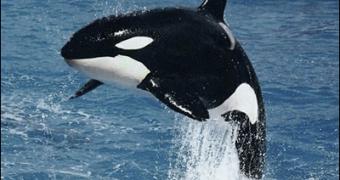1. The killer whale or orca is, together with the Great White Shark, the top predator of the oceans. The name of "whale" is deceptive, as this cetacean is not even a toothed whale, but a dolphin. That's right, the largest of all: males can be up to 8 m (26 ft) long and weigh up to 8 tonnes. The mouth is adorned with 50 dagger-like teeth.
2. The appreciation of killer comes from a research made in 1862, when the Danish zoologist D. Eschricht found, inside the stomach of an adult orca, the remains of 13 dolphins and 14 penguins. Other authors took these prey as whole animals and this is how the animal got the fame of being extremely voracious, even if, in fact, those were the remains of successive feedings. In fact, orcas kept in captivity proved rather gentle, intelligent, playful, curious and very collaborative with the humans.
But the killer whales really attack huge baleen whales, included the largest animals of all times, the blue whale. Usually, the pack of orcas attack a young animal: some individuals grip the baleen whale of its tail, while the others bite the head of the animal until it dies of bleeding. In other cases, the orcas impede the baleen whale to ascend for breathing, asphyxiating it. Orcas usually consume the tongue and the lips of the whale ignoring the rest of the body. The attacks are usually made by larger males, while the females and the young stay aside, waiting for the end of the fight. Orcas are the only natural predators of the baleen whales.
Despite this, the base of the orca diet is made by fish (herrings, mackerels, salmons, tuna, cod, and even sharks), cephalopods (cuttlefish and squids) and more rarely sea mammals, like dolphins, toothed whales (narwhals, belugas), walruses and especially seals and eared seals (sea lions and fur seals). The orcas attack near the beaches where these animals installed their colonies when the animals enter the water for feeding. 20 orcas can kill all the young eared seals of a colony in just one hour. In the Antarctica, penguins are attacked, too. An adult orca consume 45 kg (100 pounds) of food daily.
3. The killer whale seems to be one of the species not affected by global warming. Instead, the melting of the polar ice increases their hunting domain.
If, in the 1980s, 5 - 10 summer killer whales visited annually the Hudson Bay (on northern Canada), by 2006, the population jumped to about 30 in 2006, due to the sharp decline of ice cover in the Arctic. These orcas come from the northern Atlantic Ocean, near Iceland or Nova Scotia.
4. The killer whale reaches 50 km (31 mi) per hour, being the fastest cetacean. This speed allows them to execute breachings that can be 5-6 m (16-20 ft) high and 11 m (36 ft) long.
5. In orca groups, individuals form very strong bonds, more powerful than in other cetacean species. The dominant males keep a harem of 3-4 fertile females they will live with to the end of their lives, raising together more generations of young orcas. These large families comprise young individuals, males and females, mixed with adults.
6. The killer whale (Marhenurh) was a sinister spirit for the Amerindians of the Pacific coast of North America, an evil tyrant of the sea, able to kill even the Thunder Bird. The orca was represented with its large teeth and... gills, as Indians believed all the water creatures had gills, and land animals ears. Of course, the orca breaths through lungs, like any mammal.

 14 DAY TRIAL //
14 DAY TRIAL //